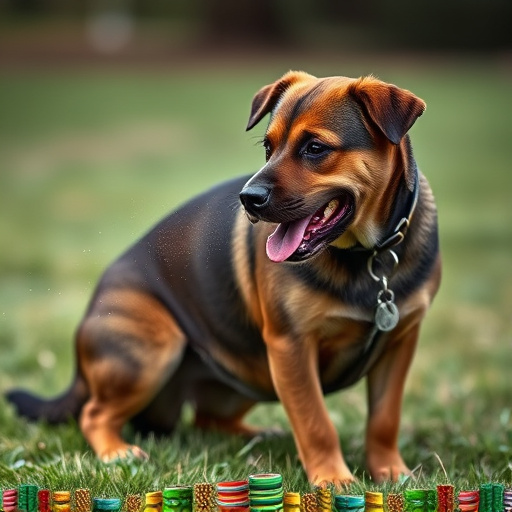Maintaining pepper spray in your car (with a 1-3 year shelf life) is crucial for self-defense against dog attacks. Store it in an accessible, dry location, check for damage or leaks, and ensure the canister's integrity. Keep it away from extreme temperatures and sunlight. Regular inspections can extend its lifespan beyond 2-3 years. Understand how and when to deploy it during encounters, staying calm and assessing the dog's behavior, while adhering to local laws regarding self-defense tools.
In many situations, dog attacks can be unpredictable and severe. Fortunately, pepper spray has emerged as a powerful tool for personal defense against these incidents. This article explores how pepper spray, specifically designed for animal encounters, can deter aggressive dogs while offering vital time to escape. We’ll delve into its effectiveness, proper usage techniques, and essential shelf life and storage considerations, including keeping it readily available in your car for quick access during unexpected dog attacks.
- Understanding Pepper Spray for Dog Attacks
- The Role of Mace in Personal Defense Against Dogs
- Shelf Life and Storage Considerations for Pepper Spray
- Effective Use Strategies During Dog Encounters
Understanding Pepper Spray for Dog Attacks
Pepper spray is a popular and effective self-defense tool, especially for dog attacks. It’s a non-lethal option that temporarily incapacitates an aggressor by causing intense irritation to the eyes, nose, and throat. When faced with a dog attack, a quick burst of pepper spray can provide valuable time to escape or call for help.
Knowing the pepper spray shelf life in your car is crucial. Unlike traditional firearms or stun guns, pepper spray has a limited lifespan. Regular maintenance and proper storage are essential to ensure its effectiveness when needed. Most pepper spray canisters have an expiration date printed on them, usually ranging from 1 to 3 years. Keep it readily accessible in your vehicle, easily reachable in case of an emergency, and regularly check for any signs of damage or leaks.
The Role of Mace in Personal Defense Against Dogs
In the event of a dog attack, having a means of self-defense is crucial for protecting yourself and others. One often-overlooked tool in personal defense against dogs is pepper spray. Unlike traditional mace, which contains chemicals that can cause temporary blindness and respiratory distress, modern pepper sprays are designed to specifically target a dog’s sensitive eyes and nose, causing them to temporarily incapacitate or retreat.
When considering self-defense options, it’s important to note the pepper spray shelf life in car or any other storage location. Properly stored pepper spray can maintain its effectiveness for several years, but this varies based on brand and storage conditions. Always check the expiration date and follow the manufacturer’s guidelines to ensure maximum potency when facing a potential dog attack. This simple yet effective tool can be a game-changer, providing you with the time needed to escape or seek help, thus underscoring its significance in any personal defense strategy against dogs or other threats.
Shelf Life and Storage Considerations for Pepper Spray
Pepper spray, a popular and effective self-defense tool against dog attacks, should be stored properly to maintain its potency and ensure longevity. The shelf life of pepper spray varies depending on factors like manufacturing quality, storage conditions, and active ingredients. Typically, most brands offer a shelf life of 2–3 years from the date of production. However, this can be extended with proper care.
When storing pepper spray in your car, consider keeping it out of direct sunlight, extreme heat or cold, and away from potential moisture sources. The dashboard is often recommended as a storage location due to its consistent temperature and accessibility. Always store it in the original packaging, if possible, and keep the seal intact to prevent contamination. Regularly check for any signs of damage or leakage, and replace the spray if it shows any deterioration in performance.
Effective Use Strategies During Dog Encounters
During dog encounters, knowing how and when to deploy a mace can be crucial for your safety. Start by staying calm; many dog attacks can be avoided or defused through patience and understanding. Assess the dog’s behavior: is it aggressive, scared, or simply curious? If the dog shows signs of aggression, spray towards its face and eyes from a safe distance. The pepper spray can temporarily disable the dog, giving you time to retreat or call for help.
Remember, the key is to use mace as a last resort when facing an out-of-control dog. Always keep it readily accessible in your car—considering its shelf life and replacement options, like regular updates of pepper spray—so that it’s ready when needed. Additionally, familiarize yourself with local laws regarding self-defense tools to ensure their legal use during such encounters.
When it comes to protecting yourself from dog attacks, pepper spray is a valuable tool. Its effectiveness, combined with proper storage and knowledge of usage techniques, can significantly enhance your safety during encounters with aggressive dogs. Remember to keep pepper spray readily available, especially in your car (considering its shelf life and placement), and be prepared to use it swiftly and accurately if needed. With the right preparation and understanding, you can deter potential threats and ensure your well-being.
